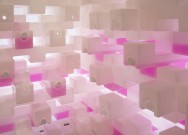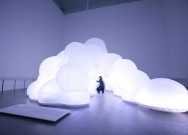Rucksackhaus
von Stefan Eberstadt

Der Münchner Künstler Stefan Eberstadt hat einen Wohnbehälter entworfen, der einfach vor das Haus geschnallt wird und bei einem Umzug wieder mitgenommen werden kann. Rucksackhaus nennt er seinen neun Quadratmeter großen Wohnbehälter.
Der würfelförmige Kubus ist eine Art begehbare Skulptur, mit ausklappbaren Einrichtungsgegenständen. Er ist in Skelettbauweise und Stahlkonstruktion errichtet und besteht außen aus Wasser abweisendem Betoplan, (kunststoffbeschichtetes Holz) und innen aus Birkensperrholz. In die „Höhle“ gelangt man über das Fenster am Haus.
Ecologic Pavilion in Alsace
by Studio 1984 (2012)
In search of the architecture of the lesser impact, the “nest” is largely inspired by agricultural vernacular constructions. Its familiar shape and texture pay homage to traditional barns and are an attempt at restoring their discreet charm.
paraSite
by Michael Rakowitz

ParaSITE: Custom built inflatable shelters designed for homeless people that attach to the exterior outtake vents of a building’s Heating, Ventilation, and Air Conditioning (HVAC) system.
Final Wooden House
by Sou Fujimoto
A place that one thought was a floor becomes a chair, a ceiling, a wall from various positions. The floor levels are relative and spatiality is perceived differently according to one’s position. Here, people are distributed three-dimensionally in the space. This is a place like an amorphous landscape with a new experience of various senses of distances.
The NA House
by Sou Fujimoto
Described as “a unity of separation and coherence”, the house acts as both a single room and a collection of rooms. The loosely defined program and the individual floor plates create a setting for a range of activities that can take place at different scales.
Casa Umbrella
by Kengo Kuma
Exhibition: Casa Per Tutti (House for All)
La Triennale Di Milano, 2008
This „Casa Umbrella“ is composed of each triangle on a regular icosahedron replaced by an umbrella. A triangle created by the bones by an umbrella is utilized as a truss structure, and every single detail is adapting the detail of a common umbrella.
Water Branch House
by Kengo Kuma
Exhibition: MOMA Home Delivery Fabricating the Modern Dwelling, 2008
Water block is a piece of plastic tank. By piling them up, you can build anything from furniture to a house. It is very light and easy to carry around. Water or other types of liquid can be stored inside. It is in the shape that each cube of 100×100mm is connected staggeringly so they can be turned into a variety of shapes.
t-room
by Kengo Kuma
I felt that I wanted this tearoom to be soft and supple, in a similar way, for in my mind the tearoom is a place antithetical in character to our rigid and highly regulated society. Instead of bits of fibers I have employed polyester mesh, and instead of earth, silicon, a material used in artificial skin.
Oribe Tea House
by Kengo Kuma
A temporary, mobile tea room. Corrugated plastic boards 5mm thick are arrayed at 65mm intervals and fixed together using banding bands. Once the bands are unfastened, the tea room returns to an assembly of cheap elements, making it easy to move. The entire form resembles an irregularly-shaped cocoon, and is an homage to Furuta Oribe’s deformed tea ceremony bowl.
Boxhome
by Rintala Eggertsson Architects
An ecological sustainable design, Boxhome, which was designed by Sami Rintala architect to explore quality of space, material and light over size. This dwelling has 19m2 (200sqft) of living space, subdivided in four rooms that are covering the basic functions of the house and distributed at different levels.
Read-Nest
by Dorte Mandrup Architekten
Measuring only 10 m2, Read-Nest is a small pre-manufactured structure that is designed to sit in the landscape like an architectural folly. Being flexible in both situation and use, the owner can place Read-Nest where he or she feels would best suit their needs, whether for study, relaxation or both.






























